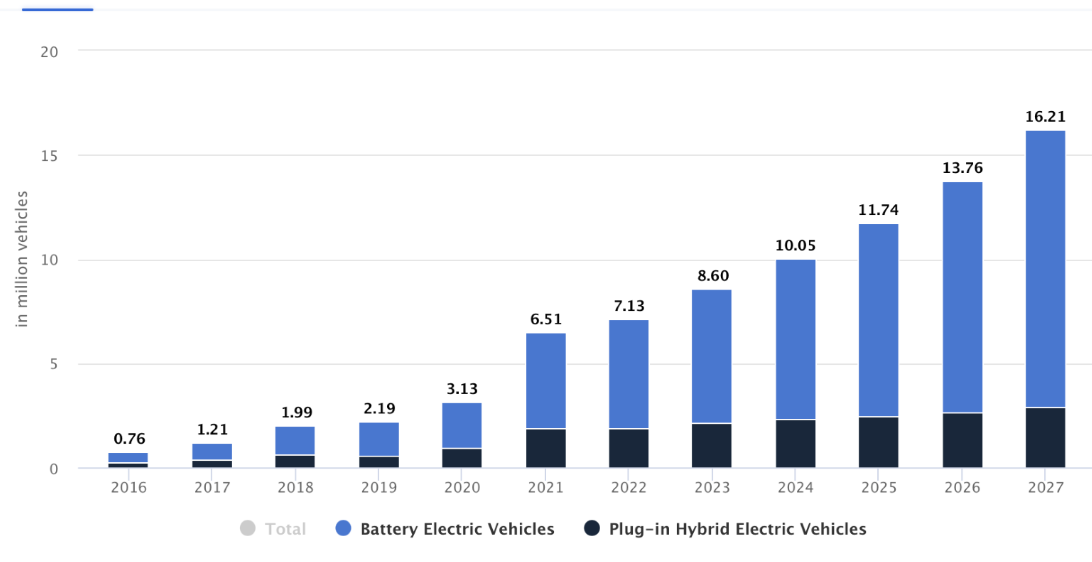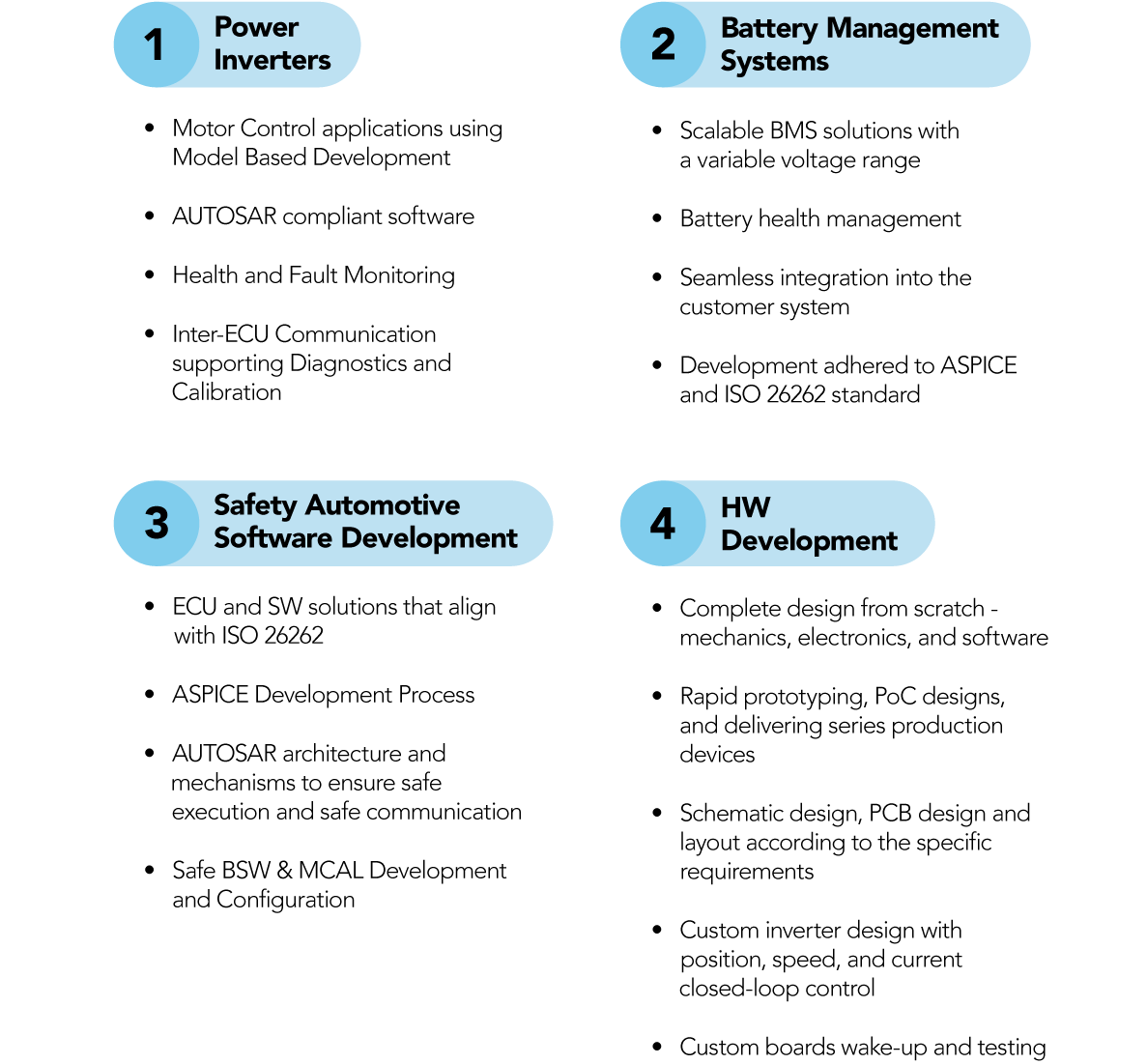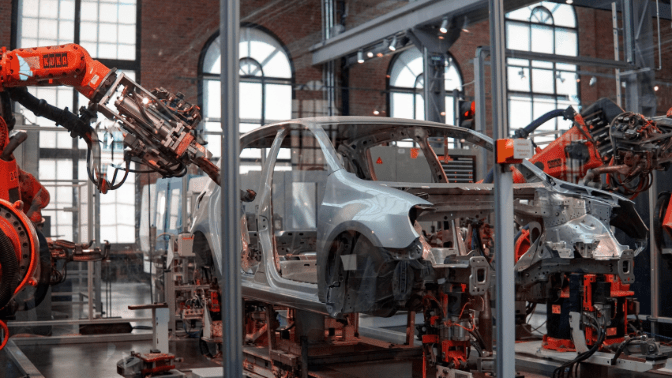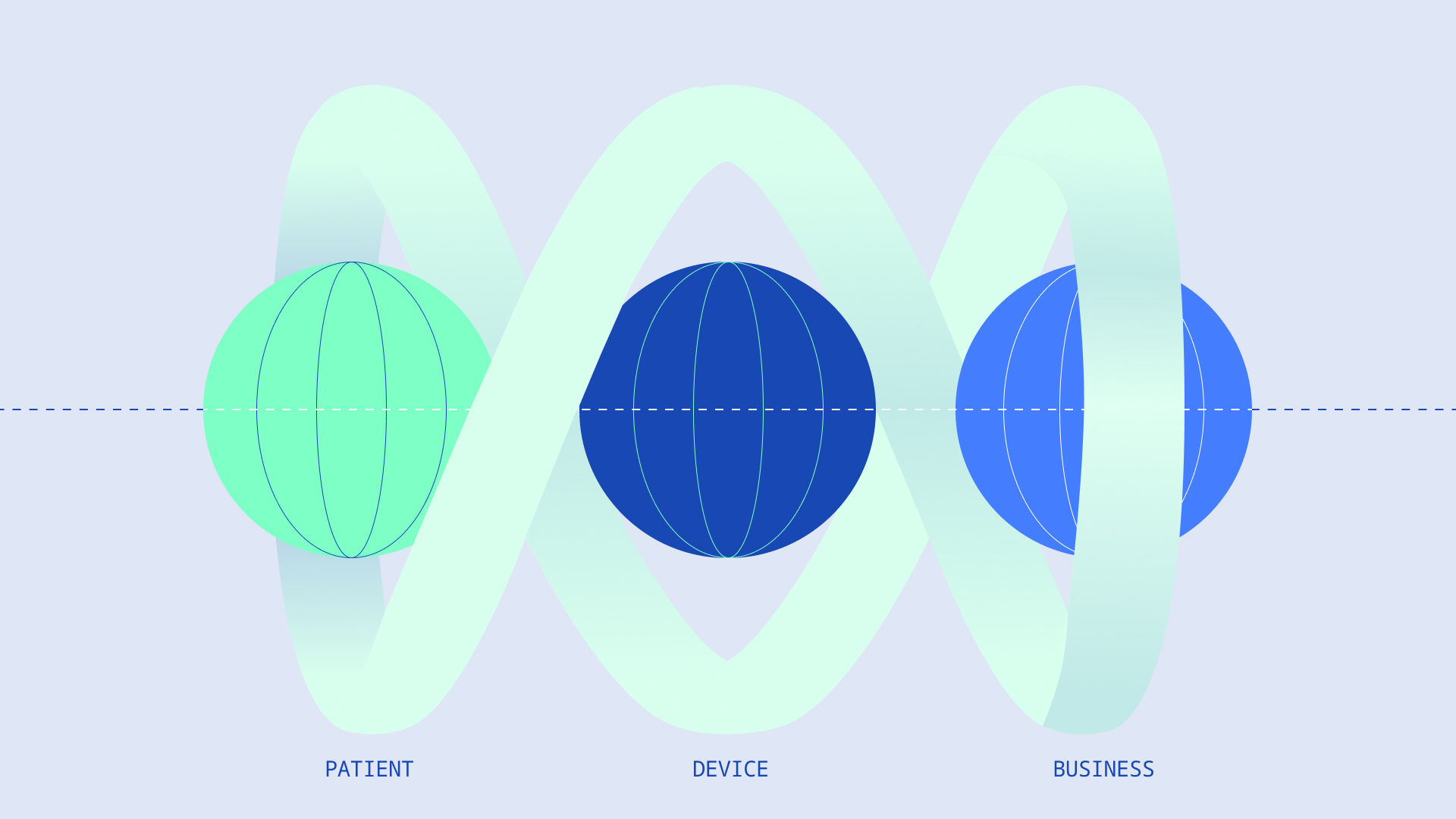2038 could be the first year with more than 50% battery-electric vehicles on the road. (Source: CLEPA & Roland Berger 2022 Study)
The global electric vehicle market size is projected to grow from 8,151 thousand units in 2022 to 39,208 thousand units by 2030, at a CAGR of 21.7% (2022-2030). (Source: Electric Vehicle Market)
The top automakers are expected to account for more than 70% of global EV production by the year 2030 (compared to 2022 when they represented only 10% of all EV manufacturers). (Source: S&P Global Mobility)
Electric cars need around 30% fewer aftermarket components, but create significant new opportunities. (Source: CLEPA & Roland Berger 2022 Study)
The Present State of Electric Vehicles
Despite the Covid-19 crisis, electric vehicles are experiencing a rapid growth. EV sales have surged by 160% in the first half of 2021 compared to a year earlier, representing 26% of new sales in the global automotive market, with growth in all three top auto markets: the US, China and Europe. There has been much demand for higher sustainability over the past few years and EVs have been responding to these challenges as well.

Source: Statista
What are the benefits?
Lower cost — For drivers looking for a cheaper way to get around, electric vehicles can be a huge investment. The price range varies depending on the model, features, type and make. There is an EV model that suits everyone’s preferences and requirements.
Cheaper to maintain — Compared to most diesel and petrol cars, EVs are much cheaper especially over the full lifetime of the vehicle. From enhanced fuel efficiency and special government grants to lower cost of electricity and reduced maintenance requirements, there are many factors that influence the price of electric vehicles.
Environmentally friendly — Fully electric cars have zero tailpipe emissions which makes them cleaner, greener, and overall better for the environment. E-revolution has been pushing car manufacturers and OEMs to address the challenges and enable smoother transition to general adoption of environmentally friendly vehicles. With technology advances that will enable more efficient, more quiet engines and more environmentally friendly batteries, the future of EVs seem bright.
More enjoyable driving experience — the quietness of electric vehicle makes driving much more comfortable and reliable. Electric vehicles bring the whole driving experience to a higher level as it allows you to glide and zip through traffic.
Fast and easy home charging — Charging electric vehicles is fast, simple, and cost-efficient. Charging units can be installed outside the owner’s home, allowing them to easily charge a vehicle using a simple charging cable when they are parked up.
Trends
Greater energy demand and improved infrastructure for EVs — Currently, most of the energy needed for EVs is private, either at home or in companies’ parking lots. However, the number of charging points will balloon in the future — these will be more accessible at public parking spaces, service stations. According to some estimates, the number of charging points will increase tenfold and will be close to that of private vehicle charging. Another important trend to watch for is improved infrastructure for EVs. Currently, there is a lack of infrastructure in rural areas also known as “charging deserts.” Fortunatley, new infrastructure laws will provide better access to charging stations across the US.
The graph below demonstrates the number of public charge points in Europe by 2025 and 2030.

Source: Transport and Environment
Sustainability initiatives — Sustainability needs are growing. As a part of the European Green Deal, the EU set a net-zero automotive emissions target for 2050 and more than 15 nations announced that they will no longer use ICE (internal combustion engine) by 2035. Around 90 % of consumed energy in US transportation only comes for petroleum. There are a number of car manufacturers including General Motors, Ford and Mercedes who announced that they will sell only zero-emission vehicles by 2040. This will drive a cleaner and more sustainable mobility in the future and a greater number of e-vehicles on the roads globally. Another growing trend in EV charging is solar-powered charging. Solar-powered chargers are already on the rise, allowing consumers to use renewable energy to power their electric vehicles. This shift could have a major impact and make EVs more competitive over gas-powered cars.
Government incentives — Governments across the globe are making incentives that should encourage drivers to go electric. Forty-five US states have been offering tax credits for EV purchases and EV charging infrastructure, smaller vehicle registration fees and loans for alternative fuel technologies.
Improved driving range and the emergence of new EV-specific apps and services — Car manufacturers are constantly working on the improvement of the main capabilities of electric car vehicles like design and processes to streamline the driving range of new versions of electric cars. For instance, a driving range of Chevrolet Bolt significantly increased from 200-plus miles to 295-plus miles of range. In 2023, there will also be an emergence of new apps specifically designed for charging stations and electric vehicles. These would allow consumers to access the information about EV charging stations more quickly and find nearby parking slots more easily. What’s more, we expect to see the development of new services and products designed to meet EV’s owners’ specific needs such as dedicated insurance packages and subscription-based charging plans.
Consumers are increasingly buying EVs — More and more consumers have accepted that the future of automotive is electric. According to one survey, 60% of consumers show an interest in purchasing electric vehicles. This and other reports show a significant shift towards purchasing of electric vehicles. While an average consumer would have thought “I would never buy a car” just a few years ago, now a growing number of consumers are wandering “what if all the cars were electric”.
Big tech companies are entering the EV industry — Besides the automotive giants like Tesla and the more recent Rivian as well as traditional automakers who have also recognized the widespread adoption of electric vehicles, there is the third group who is showing interest in investing in EV market — tech companies.
Affordability — EVs are becoming more affordable, and according to predictions, they might become more affordable than gas-powered vehicles in only 2 or 3 years from now. Dr. Jeffrey Sachs, an economist and sustainability expert, explains that consumers will not have that much choice but to buy EV because all manufacturing companies are now focusing their attention on Tesla, trying to recreate them or create better versions of them. Also, over the years, the cost of battery packs has plummeted — the cost of a lithium-ion battery pack decreased for impressive 89%, from an average cost of $1,200 per kWh in 2010 to $132 per kWh by the end of 2021. Interestingly, the cost of traditional vehicles rose by 2.2% from 2020 to 2021 which is not the case with EVs whose cost decreased by 10.8% during the same period.

Source: Exro
Risks
Wrong charging strategies can cause counter effect
EVs can help reduce greenhouse gas emissions only if there is a strategy on where, how and when those vehicles are charged. University of Michigan study found out that both emissions directly tied to charging the vehicles and emissions that come from manufacturing the batteries must be taken into account to maximize the benefits of using electric vehicles. For instance, if batteries are charged in the wrong way, this will lead to early battery replacement.
According to the study, if a vehicle is charged immediately up to 100 % this can result in much time spent sitting at the depot/charging station with a full battery. Consequently, this will cause the battery to wear out much more quickly and eventually be replaced, which will then add to higher greenhouse gas emissions. This research also dived deeper into the popular counter-argument against going electric, based on which power grid infrastructure used to charge the vehicle’s battery is far from carbon neutral.
Charging stations are few and far
Range anxiety is slowing EV adoption. Majority of consumers are not willing to buy EVs until they know that they will be able to recharge the batteries when and where they want. According to the last year’s Shell Recharge Solutions EV Driver Survey 2022, almost half of EV drivers want to see improved charge point availability.
At the same time, potential investors in EV charging points or any other EV infrastructure hesitate about investing in charging points until more electric cars are on the roads. On top of this, although some users own private chargers at their homes, many are still able to install CP (charging point) at home. All these factors cause a slow adoption of electric vehicles which can ultimately bring the entire EV market to a standstill.
Less experienced drivers of EVs rebel against a number of inconveniences
Based on a survey conducted in September and October 2020 by Plug In America, where 3,500 EV drivers were surveyed, more than half of them (almost 60 %) reported that they have problems with public charging. Most of these respondents drove non-Tesla vehicles and they mostly complained about a non-functional charger. Another problem they complained about were charging stations — they are not designed in a way to accommodate cars with trailers (which is not the case with regular gas stations).
On top of this, each EV model’s battery can have different charging time and capacity and automakers must understand and consider a set of open standards for the plug type, payment methods and charging protocols. Even when chargers are fully functional, they may face various issues including plugs becoming unseated, chargers rebooting, cars and chargers having trouble communicating, fewer charging stations, too much demand at available stations, broken chargers, confusing payment systems, huge electricity rates, and general uncertainly over how long and how much their cars need to be charged.
All of this can interrupt a charging session or lead to longer charge times. As Melanie Lane, CEO of Shell Recharge Solutions Europe, says: “The industry needs to understand the challenges of EV drivers in order to facilitate mass adoption and that’s why the findings of our survey are critical. It’s clear that there is a growing passion for EVs, where drivers are motivated by technology, cost, and sustainability, but it’s also evident that the lack of a good user experience remains a key barrier to mass adoption. To continue momentum and encourage further EV adoption, these issues must be addressed.”
The bottom line is that, as Joe Daniel, an energy analyst at the Union of Concerned Scientists explains for the First Street Journal, EVs will take off once they are as convenient as gas-powered cars — that’s the whole point of this big purchase.
High energy consumption
Electric cars have a high energy consumption caused by both driving and other invisible energy consumers including entertainment/infotainment systems, air-conditioning, heating, battery thermal management. Batteries account for 20% to 30% of total cost, which makes them one of the most expensive components of EVs. To achieve widespread social acceptance of electromobility, enormous efforts are being made, such as significant improving of the range and the fast-charging capability of electric vehicles.
Most EVs currently being produced have 400v internal architecture, but this will change. One of the most efficient ways to optimize performance is to increase voltage level from 400V to 800V. By adopting an industry standard of 800V, EVs will be charged in half the time taken with a typical 400V system. The first EV that used 800 v drive system was the Porsche Taycan, a luxury sports saloon, launched in 2019. Porsche explains that by using a fast-charger the Taycan’s huge 93k wh battery can gather enough juice for the car to travel 100 km in little more than 5 minutes.
Also, some of the early adopters of 800 v system are Audi eTron, Hyundai Kia EV6, and BYD Blade Battery. Another challenge here is that this system does not require implementing a whole new battery technology, but it means that electrical components of EVs will need to change. For instance, it requires wiring up more of the battery’s cells in series and the associated electronics need additional re-engineering. As the EV sales are increasing, specialist chipmakers have been investing their efforts into building semiconductors that can operate at 800v.
What’s next for EVs
The vehicle of the future will be electrically, battery or hybrid powered, due to governmental requirements to reduce CO2 and NOx emissions as well as scarce fossil fuel resources. This means reinventing the established vision of a car and brings a lot of challenges, developments, and changes with it. The transition from the ICE age to the EV age over the coming decade will represent rapid change in most countries.
Technological advancements are most apparent with electrical mobility. According to McKinsey, the automotive industry will introduce 600 new plugin-hybrid EVs and 600 new battery-electric vehicles (BEVs), which will further significantly increase the customers’ choice. OEMs will invest more than 120 billion dollars in capital expenditures to BEVs, which is about 25 to 30 % of the total. Overall, capital expenditures for BEVs will double in the next five years and investments in other vehicles will hugely decline.
Electronics and software
Emerging technologies including 5G, quantum computing, and urban-air mobility could transform mobility. Also, it is predicted that the software and electronics market will double in size by 2030. Electronic control units (ECUs) and domain control units as well as software functions, middleware and operating systems will become more important and see steady growth in the following years.
Advancement of battery technology
Companies striving to meet the world’s growing appetite for electric vehicles are more and more focused on new battery technologies. There are many EV battery technologies emerging with a promise to have a major impact on the future of EVs and two most dominant ones are Lithium-ion and lithium-iron phosphate. Automakers and battery companies including General Motors, Tesla, and China’s CATL are investing their resources into building cheaper, lighter and denser batteries for significant gains in performance or costs.
A broad shift to 800V systems
There is a wide range of benefits of implementing 800v system such as substantially lower volume and weight, faster charging, bigger comfort and better performance. This improvement can already be seen in high-performance vehicles. However, this is also evident in low-cost vehicles. This will have an impact on everyone involved including OEMs, Tier 1, Tier 2 and raw materials suppliers and supported by governmental-driven measures. Through energy efficiency improvement, unnecessary power loss which happens when being in a traffic, or when charging or discharging the car will also be decreased. It’s important to keep in mind that scaling to this 800v systems, all parts in e-drive’s motor construction need to adapt to the new system and the entire mechanical sub-systems needs to be electrified. The bottom line is that both 400v and 800v systems will play key roles in the development of automotive industry.
By 2035, the largest automotive markets will go electric
The adoption of EVs vary greatly by region. While in China, consumer pull is very strong, it, Europe is mainly regulation-driven, and the USA EV sales have been growing steadily due to both consumer interest and regulatory pressure. McKinsey points out that EVs would need to account for 75 % of passenger car sales across the globe by 2030, and Europe will be the one that will electrify the fastest and will remain the global leader in electrification when it comes to EV market share.
Electrification will have a major impact on the entire automotive supply chain
The shift to electrification will disrupt the entire supply chain and significantly impact market size for automotive components. Critical components for electrification including batteries and electric drives and for autonomous driving like ranging sensors and light detection will make up about 52 percent of the entire market by 2030. On the other hand, critical components used for ICE vehicles such as engines, conventional transmissions, and fuel injection systems will see a significant drop to around 11 % by 2030.
EVs will help decarbonize the planet
Based on the recent International Council on Clean Transportation (ICCT) analysis, the shift from ICE to BEV will heavily reduce a complete lifecycle of CO2e emissions by almost 65 %. However, in this process of adoption of EVs, materials and production in EVs lifecycle will become the dominant source of emissions.
Are you ready for the E-revolution? How can we help?
HTEC has a long and successful history in delivering end-to-end solutions for various industries, and those solutions do not include only SW, but also the HW development.
HTEC engineers have worked on numerous state-of-the-art automotive-related projects for some of the most innovative companies in the world of automotive including premium OEMs, Tier 1 and chip suppliers. By leveraging cutting-edge technologies of tomorrow and backed up by extensive experience in powertrain domain, including electric motor control, power inverters and battery management systems, our team of experts have been working on delivering the next generation of electric vehicles supporting faster charging, higher speeds and longer-range.

How we help spark the electric vehicle revolution
1. Developing Power Inverter solutions that are capable of operating high-speed motors efficiently
In electric cars, the inverter is the component that changes the direct current (DC) from the battery to alternating current (AC) to be used by the motor system. Understanding the concepts and challenges behind next generation power inverters and using cutting-edge technologies, HTEC is helping create efficient yet ultra-fast charging capable inverters with dedicated Motor Control applications and a range of supporting diagnostic, communication, time, safety, fault, and health management services which enable safe execution and safe communication with other ECUs.
2. Developing Battery Management Systems solutions
Battery Management System manages the health of the battery pack installed in EVs and protects the battery from operating outside its safe operating area. The main functions of a Battery Management System are:
- Battery protection to prevent operations outside its safe operating area
- Battery monitoring (voltages, temperature, capacity, state of charge, power consumption, remaining operating time, charging cycles, etc.)
- Battery optimization
3. Developing Software solutions that adhere to highest functional safety standards
No matter if we talk about ECU development, or an ADAS function or a simple math library, if the SW goes into the car and to series production while being a safety relevant, it must be developed by considering functional safety requirements from the ISO 26262. Here we focus on four important aspects:
- Ensuring the full development traceability with special focus on tracing ASIL assignment from requirements, via architecture and design to the code and tests using ALM tools
- Establishing freedom from interference with mechanisms covering memory, timing, execution, and exchange of information
- Designing and Developing SW according to methods of ISO 26262-6 and performing Static Code Analysis (MISRA and HIS metrics)
- Performing DFA and FMEA analysis and applying right safety mechanism
This allows us to have a meaningful and transparent development of both safety and non-safety functionalities and to avoid and address diverse types of failures and issues related to the automotive software development lifecycle.
HTEC Experience in Powering Electric Vehicles

Driven by our mission to get out of our comfort zones and search for innovative solutions to some of the most complex worlds’ problems, our team of skilled domain experts is here to help you navigate your digital journey towards a more connected and digitized world.
Connect with Stevica Djukic or reach out to our experts to learn how we can help you get beyond the wheel.






